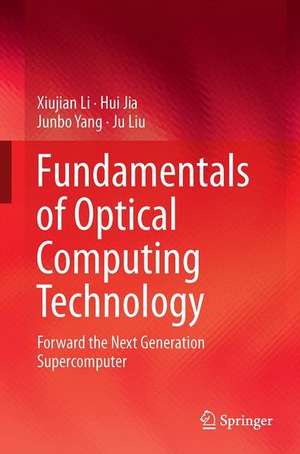Fundamentals of Optical Computing Technology: Forward the Next Generation Supercomputer
Autor Xiujian Li, Zhengzheng Shao, Mengjun Zhu, Junbo Yangen Limba Engleză Hardback – 24 mai 2018
| Toate formatele și edițiile | Preț | Express |
|---|---|---|
| Paperback (1) | 999.60 lei 6-8 săpt. | |
| Springer Nature Singapore – 11 feb 2019 | 999.60 lei 6-8 săpt. | |
| Hardback (1) | 1005.61 lei 6-8 săpt. | |
| Springer Nature Singapore – 24 mai 2018 | 1005.61 lei 6-8 săpt. |
Preț: 1005.61 lei
Preț vechi: 1226.35 lei
-18% Nou
Puncte Express: 1508
Preț estimativ în valută:
192.45€ • 208.97$ • 161.65£
192.45€ • 208.97$ • 161.65£
Carte tipărită la comandă
Livrare economică 23 aprilie-07 mai
Preluare comenzi: 021 569.72.76
Specificații
ISBN-13: 9789811038471
ISBN-10: 9811038473
Pagini: 346
Ilustrații: XII, 295 p. 266 illus., 76 illus. in color.
Dimensiuni: 155 x 235 mm
Greutate: 0.61 kg
Ediția:1st ed. 2018
Editura: Springer Nature Singapore
Colecția Springer
Locul publicării:Singapore, Singapore
ISBN-10: 9811038473
Pagini: 346
Ilustrații: XII, 295 p. 266 illus., 76 illus. in color.
Dimensiuni: 155 x 235 mm
Greutate: 0.61 kg
Ediția:1st ed. 2018
Editura: Springer Nature Singapore
Colecția Springer
Locul publicării:Singapore, Singapore
Cuprins
Preface.- Summary of Optical computing Technology.- Semiconductor MQWs Photo-electronic Logic Devices.- Minitype Light Source for Optical Computing.- Micro- and Diffractive Optical Elements.- Optical Storage.- Parallel Optical Interconnections.- Optical buffer and full-optical synchronization.- Summary.
Notă biografică
Prof. Xiujian Li is a professor at College of Science, National University of Defense Technology, Changsha, China. He receives his Bachlor, Master and PhD degree from National University of Defense Technology in 1997, 2002 and 2007, respectively. He has been teaching in National University of Defense Technology for 13 years. He has been director of Modern Ultra-fast Optics Lab in NUDT since 2009, and co-director of Center of Materials Science in NUDT since 2011. In 2011-2012, he visited Columbia University, USA as an visiting professor. He has published more than 50 peer-reviewed journal and transaction full papers in English (including papers in press). His research focuses on Optical information processing, Silicon photonics, Ultra-fast optics and Optical computing technology.
The co-authors, Dr. Zhengzheng Shao, Mr.Mengjun Zhu and Prof. Junbo Yang are all from the College of Liberal Arts and Sciences, National University of Defense Technology, China.
Textul de pe ultima copertă
This book presents the principles, experimental technologies, up-to-date research findings and applications of various optical-computing technologies and devices. It also discusses semiconductor multiple quantum well (MQW) photoelectronic devices, vertical-cavity surface-emitting lasers (VCSELs), lasers, micro optical elements and diffractive optical elements, optical storage, optical parallel interconnections, and optical-buffer technology as the main technologies for optical computing. Furthermore, it explores the potential of optical-computing technology. It offers those involved in optical design, photonics, and photoelectronic research and related industries insights into the fundamentals and theories of optical computing, enabling them and to extend and develop the functions of fundamental elements to meet the requirement of optical-computing systems.
Caracteristici
Highlights advanced research in the field of nano-photonics, nonlinear optics, and ultra-fast optics, as well as advances in data encoding, supercomputer, and optical communication Discusses the future development of optical computing and high-performance supercomputers or their components for big data processing Provides a guide to the architecture, major elements and operation methods for emerging all-optical supercomputers for the next 5–10 years
